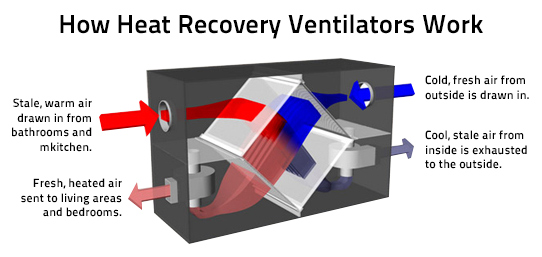A Simple Guide to HRV Filter Cleaning
Wiki Article
Checking out the Advantages of Heat Recovery Ventilation for Power Effectiveness in Homes
Heat Recovery Ventilation (HRV) systems use property owners a functional method to enhancing power efficiency. By recovering heat from outgoing air, these systems can substantially minimize cooling and heating expenses. Furthermore, they give a steady supply of fresh air, improving indoor air high quality and convenience degrees. As house owners think about lasting options, understanding the subtleties of HRV systems ends up being progressively important. What factors should one examine before making such a financial investment?Comprehending Heat Recovery Ventilation Equipments

Exactly How HRV Improves Indoor Air Top Quality

Energy Financial Savings: The Economic Benefits of HRV
Maximizing energy efficiency, heat recovery ventilation (HRV) systems supply substantial financial benefits for property owners. By recuperating and reusing heat from exhaust air, HRVs substantially reduce home heating and air conditioning expenses. This modern technology can bring about power savings of approximately 30%, depending upon environment and usage patterns. Homeowners often notice decreased utility costs soon after installation, making HRVs an economically sensible investment with time. Additionally, lots of areas offer incentives or discounts for energy-efficient upgrades, additionally enhancing the monetary allure. As energy rates remain to increase, the cost-effectiveness of HRVs comes to be progressively clear. On the whole, the incorporation of HRV systems not only advertises power efficiency but also adds to long-lasting financial savings for check out this site households.The Environmental Effect of Heat Recovery Ventilation
A considerable environmental benefit of heat recovery ventilation (HRV) systems depends on their ability to minimize overall power intake. By redeeming warmth from exhaust air and moving it to inbound fresh air, HRV systems minimize the need for energy-intensive home heating and cooling down techniques. This Site This reduction in energy need contributes to reduce greenhouse gas discharges, as much less fossil fuel is needed to preserve comfy interior temperatures. Additionally, HRV systems improve interior air high quality by successfully trading stale air with fresh outside air, minimizing reliance on mechanical cooling systems that can hurt the atmosphere. In general, the application of HRV systems sustains lasting living techniques and aligns with worldwide initiatives to battle environment adjustment by advertising power efficiency in domestic setups.
Choosing the Right HRV System for Your Home
Exactly how can homeowners guarantee they choose the appropriate heat recovery ventilation (HRV) system for their needs? Initially, they must assess their home's dimension and layout, as these variables affect air flow demands. Next off, evaluating the system's effectiveness ratings is crucial, as higher rankings suggest far better efficiency and power financial savings. Homeowners need to also consider installment and upkeep prices, contrasting different brands and versions for value. Furthermore, it is essential to review sound levels, as some systems operate even more quietly than others. Consulting with heating and cooling professionals can give customized suggestions based upon certain home problems. Checking out individual reviews and warranties can assist in making an informed decision, guaranteeing that the picked HRV system successfully enhances indoor air high quality and power effectiveness.Regularly Asked Concerns

Exactly how Commonly Should I Tidy or Keep My HRV System?
The frequency of cleansing or keeping a warmth recovery ventilation (HRV) system usually relies on usage and ecological aspects. Generally, it is recommended to do upkeep every 6 months to ensure peak efficiency and air top quality.
Can HRV Systems Aid Lower Moisture Levels Inside Your Home?
HRV systems can efficiently minimize indoor humidity degrees by trading stale, damp air with fresh, drier air from outdoors. HRV Heat Recovery Ventilation. This process aids preserve a balanced interior environment, boosting convenience and preventing moisture-related concerns
What Is the Lifespan of a Regular HRV System?
The life-span of a common heat recovery ventilation (HRV) system differs, generally lasting between 10 to 15 years. Routine upkeep can prolong its performance and functional reference life, ensuring peak performance throughout its use period.Are There Any Kind Of Noise Worry About HRV Solutions?
Sound interest in HRV systems can arise, specifically from follower operation. Nevertheless, many contemporary devices are made to decrease audio levels, guaranteeing they run silently while maintaining efficiency, which deals with possible disruptions in living settings.Can I Mount an HRV System Myself, or Do I Required a Specialist?
The private contemplated whether to set up the heat recovery ventilation (HRV) system directly or employ a professional. Generally, while do it yourself installation is feasible, knowledge guarantees appropriate capability and compliance with regional building regulations, boosting system effectiveness.Report this wiki page